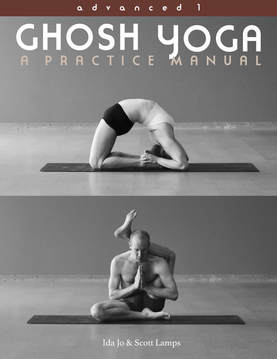|
Putting the leg(s) behind the head rounds the spine forward, a powerful counter to Full Backbending. These postures are a full-body nervous system "stretch." To access the nervous system in this group of postures, there are three elements of vital importance: 1) lengthening the spinal chord by rounding the spine, 2) compressing the nerve plexuses in the chest and abdomen, which is also achieved by rounding the spine forward, and 3) tensioning (stretching) the sciatic nerve by rotating and flexing the hip.
The spine should be "hunched" forward in these postures. Much of their benefit is in the lengthening of the nervous system on the backside of the body, including the spinal chord and sciatic nerve. The head and neck need to be upright enough to hold the foot in place behind the head, but the spine should be rounded as much as possible. Compressing the chest and abdomen calms the nervous centers there. These are the same plexuses that we stretch and stimulate in deep backbends. Here we compress them, countering the backbends. This is similar to the complimentary positions of Camel and Rabbit postures, which is why Leg Behind the Head postures should be practiced after Full Backbends. Leg Behind the Head balances and quiets the nervous system in preparation for the inner practices of Sensory Control and Meditation. Excerpt from Advanced 1 Ghosh Yoga Practice Manual
0 Comments
Leave a Reply. |
AUTHORSScott & Ida are Yoga Acharyas (Masters of Yoga). They are scholars as well as practitioners of yogic postures, breath control and meditation. They are the head teachers of Ghosh Yoga.
POPULAR- The 113 Postures of Ghosh Yoga
- Make the Hamstrings Strong, Not Long - Understanding Chair Posture - Lock the Knee History - It Doesn't Matter If Your Head Is On Your Knee - Bow Pose (Dhanurasana) - 5 Reasons To Backbend - Origins of Standing Bow - The Traditional Yoga In Bikram's Class - What About the Women?! - Through Bishnu's Eyes - Why Teaching Is Not a Personal Practice Categories
All
Archives
May 2024
|







 RSS Feed
RSS Feed